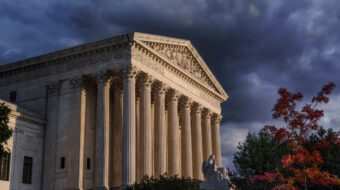[From the pww.org archives]
America has a great revolutionary tradition, and Marxism (historical materialism) is the best way to understand that tradition, appreciate it and make it live. In the 18th century, American colonists rebelled against a British empire that used them as producers of raw materials, a captive market for finished goods and a pawn in imperialist wars against France and Spain. In doing so they established the first bourgeois democratic republic, which the British revolution of the 17th century had failed to do.
The American Revolution also played a significant role in encouraging the French revolution and in leading revolutionaries throughout the Western hemisphere to overthrow the Spanish empire and establish republics.
Tom Paine’s Common Sense, the Declaration of Independence and the first ten amendments to the written Constitution, the Bill of Rights, are three of the most important revolutionary documents advancing progress in history. “An empire for Liberty,” a continental empire, was Thomas Jefferson’s blueprint for the nation’s future.
Jefferson was both the author of the Declaration of Independence and a liberal representative of the slaveholder class, if one can believe such a thing. The idea of an expanding land empire, for Jefferson, would keep the rich and poor whites united, the merchants and landowners and slaveholders happy, and avoid transforming the American political revolution into a social revolution.
By the mid-19th century Jefferson’s continental empire had, in the hands of Andrew Jackson, turned into an ugly thing called “manifest destiny,” where “superior” Anglo-Americans had the right and duty to remove Indians and take the Southwest away from Mexicans, “inferior people” who had no right to land that they were too “backward” to develop. But at the same time, workers formed the first labor parties in Philadelphia and New York, reformers fought for universal male suffrage, women’s rights, public education, social protection for the poor and ill and, most of all, the abolition of slavery.
Progressive historian Charles Beard was very right when he called the Civil War a “second American revolution,” in that the slaveholder class was destroyed as a class, and legislation to build national railroads, a national banking system, protect manufacturing, distribute public lands and advance education all followed. This transformed the United States by the end of the 19th century into a nation of immigrants from all over Europe, of diverse religions and cultures, along with the Anglo and African Americans, who were the historic core groups, and the leading industrial nation of the world.
What the revolutionary Civil War, which destroyed the slaveholder class, didn’t create was anything like equal rights for the former slaves. After a period of intense struggle, a semi-feudal system based on sharecropping and farm tenancy kept most Blacks and many poor whites tied to the land in a cycle of debt, poverty and severe malnutrition. The social system of segregation and political disenfranchisement served as the superstructure for this semi-feudal system, producing a cruel regional racist dictatorship that the capitalist class of the United States and both the national Republican and Democratic parties either openly supported or quietly tolerated to keep the working class weak and divided.
As a socialist labor movement developed in the last decades of the 19th century, capitalists used state militia, the national guard and “midnight judges” issuing anti-strike injunctions to suppress workers’ movements. Capitalists did this everywhere, but in the U.S. there were some new wrinkles that added insult to injury.
Capitalist spokesman called their activities a defense of “liberty” and “democracy” and even used the Sherman Anti-Trust Act, which on paper outlawed monopolies as “conspiracies in restraint of trade,” against unions. Also, private detective agencies, the Pinkerton and later Burns agency, among others, made strikebreaking and anti-labor industrial espionage into a cottage industry.
As the 20th century dawned, American corporate leaders had created a complicated system of carrots and sticks, playing various immigrant groups against each other and all against Blacks, even privatizing a good deal of repression while they contended that America was a country of such wealth and opportunity that anybody could become a successful capitalist and that the poor had only themselves, their individual moral flaws, to blame for not becoming prosperous. For capitalists and their controlled media and social institutions, owning property, being wealthy or at least “middle class,” became the definition for being a good American.
The real attitude of American capitalism to the working class and the American people as a whole was perhaps best expressed by the late 19th century robber baron Jay Gould, when he said, “I can hire one half of the working class to kill the other half.”
Against this powerful arrogant capitalist class, the socialist and then Communist parties would struggle to this day, along with civil rights activists, women’s rights activists, social reformers fighting for prison reform and the abolition of the death penalty, labor law reform and full employment, anti-imperialism and peace, keeping through their struggles, their victories and defeats, the living tradition of the American revolution, of Tom Paine, Frederick Douglass, alive in Eugene Debs, Elizabeth Gurley Flynn, Martin Luther King and Gus Hall.
Part two in the series:
Norman Markowitz is a Marxist historian from New Jersey. He can be reached at pww@pww.org

MOST POPULAR TODAY

High Court essentially bans demonstrations, freedom of assembly in Deep South

U.S. imperialism’s ‘ironclad’ support for Israel increases fascist danger at home

UN warns that Israel is still blocking humanitarian aid to Gaza

Resource wars rage in eastern Congo, but U.S. capitalism only sees investment opportunity






Comments